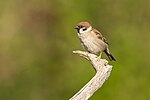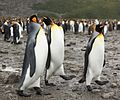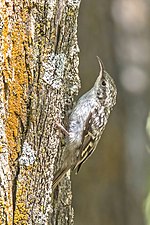Sylvioidea is a superfamily of passerine birds, one of at least three major clades within the Passerida along with the Muscicapoidea and Passeroidea. It...
6 KB (653 words) - 06:23, 1 April 2024
Passeriformes gen. et sp. indet. (Late Miocene of Polgárdi, Hungary) – Sylvioidea (Sylviidae? Cettiidae?) That suboscines expanded much beyond their region...
50 KB (4,734 words) - 12:45, 2 November 2024
Old World warbler (section Not in Sylvioidea)
"Old World warblers" with the babblers and other taxa in a superfamily Sylvioidea as a result of DNA–DNA hybridisation studies. This demonstrated that the...
30 KB (3,026 words) - 12:10, 21 September 2024
of detail, some now place the larks at the beginning of a superfamily Sylvioidea with the swallows, various "Old World warbler" and "babbler" groups, and...
30 KB (2,240 words) - 07:28, 11 October 2024
Passerida (section Superfamily Sylvioidea)
"New insights into family relationships within the avian superfamily Sylvioidea (Passeriformes) based on seven molecular markers". BMC Evolutionary Biology...
17 KB (1,958 words) - 05:32, 11 February 2024
Sundberg, P. (2006). "Phylogeny and classification of the avian superfamily Sylvioidea". Molecular Phylogenetics and Evolution. 38 (2): 381–397. doi:10.1016/j...
6 KB (404 words) - 18:00, 8 June 2024
of the Old World warblers and other bird families in the superfamily Sylvioidea (which includes the larks, swallows and tits) found that the African warblers...
9 KB (1,039 words) - 04:00, 11 August 2024
Bush-warbler (category Sylvioidea stubs)
close relatives. However, they belong to two well-distant families in the Sylvioidea, the "warbler-and-babbler" superfamily: Cettia, the cettiid bush-warblers...
2 KB (203 words) - 13:12, 25 February 2021
sequence data (Ericson & Johansson 2003). Placement in a superfamily Sylvioidea which contained birds such as Sylviidae, Timaliidae and long-tailed tits...
24 KB (2,316 words) - 07:57, 7 September 2024
Muscicapoidea. In the mid-20th century, the Turdidae and even most of the Sylvioidea were lumped in the Muscicapidae—but the Mimidae were not. Lastly, the...
24 KB (1,989 words) - 14:21, 19 August 2024
Sylviidae, which at that time was a wastebin taxon for the warbler-like Sylvioidea. The range of this genus extends through the warm regions from Africa...
5 KB (469 words) - 13:13, 9 November 2024
chromosomes. Five examples of this are now known in the songbird superfamily Sylvioidea. There is one experimentally documented case of sex chromosome turnover...
30 KB (3,662 words) - 11:06, 15 October 2024
with molecular evidence placing them as a distinctive lineage within the Sylvioidea (Old World warblers and relatives). Phylogenetic analysis has shown that...
51 KB (4,883 words) - 10:35, 7 September 2024
Scotocercidae) Family Hyliidae: hylias Family Aegithalidae: bushtits Superfamily Sylvioidea Family Sylviidae: true warblers Family Paradoxornithidae: parrotbills...
30 KB (1,938 words) - 13:58, 15 October 2024
indicates that they are too basal to belong the Passerida – let alone the Sylvioidea where the Old World babblers are placed – and they are now classed as...
6 KB (630 words) - 20:12, 29 September 2024
Sylviidae, which at that time was a wastebin taxon for the warbler-like Sylvioidea. The range of this genus extends from Europe to southeast Asia. The genus...
6 KB (548 words) - 19:41, 3 July 2024
Sundberg, Per (2006). "Phylogeny and classification of the avian superfamily Sylvioidea" (PDF). Mol. Phylogenet. Evol. 38 (2): 381–397. doi:10.1016/j.ympev.2005...
3 KB (258 words) - 23:02, 20 June 2024
Yuhina are still placed. The Timaliidae are members of the superfamily Sylvioidea in infraorder Passeri, whereas the erpornis is the closest relative of...
4 KB (478 words) - 05:12, 18 April 2024
house a clade of four families that were removed from the superfamily Sylvioidea. In 2019 Carl Oliveros and colleagues published a large molecular phylogenetic...
3 KB (275 words) - 11:34, 24 September 2024
Pellorneidae, of mostly Old World passerine birds belonging to the superfamily Sylvioidea. They are quite diverse in size and coloration, and usually characterised...
17 KB (1,491 words) - 08:02, 7 September 2024
the rockjumpers (Chaetops) and are basal to the clade containing the Sylvioidea, Passeroidea and Muscicapoidea but outside the core Corvoidea. This generic...
9 KB (1,010 words) - 19:41, 3 July 2024
flightlessness is seen in some taxa. Among the "warbler and babbler" superfamily Sylvioidea, the Locustellidae are closest to the Malagasy warblers, another newly...
7 KB (587 words) - 19:43, 24 June 2024
Sundberg, P. (2006). "Phylogeny and classification of the avian superfamily Sylvioidea". Molecular Phylogenetics and Evolution. 38 (2): 381–397. doi:10.1016/j...
17 KB (1,597 words) - 05:22, 4 January 2024
Sundberg, Per (2006). "Phylogeny and classification of the avian superfamily Sylvioidea". Molecular Phylogenetics and Evolution. 38 (2): 381–397. doi:10.1016/j...
18 KB (1,741 words) - 08:00, 7 September 2024
here, but it is highly likely to belong to the Locustellidae, or the Sylvioidea at the least. As the grasshopper warblers are the only known locustellid...
7 KB (634 words) - 19:43, 24 September 2024
Sundberg, Per (2006). "Phylogeny and classification of the avian superfamily Sylvioidea" (PDF). Mol. Phylogenet. Evol. 38 (2): 381–397. Bibcode:2006MolPE..38...
11 KB (1,109 words) - 15:39, 28 October 2024
four families removed from a larger grouping of passerine birds, the Sylvioidea. The fossil record for this group appears to be restricted to a foot bone...
9 KB (1,056 words) - 00:55, 1 April 2024
Sundberg, Per (2006). "Phylogeny and classification of the avian superfamily Sylvioidea". Molecular Phylogenetics and Evolution. 38 (2): 381–97. doi:10.1016/j...
29 KB (2,857 words) - 06:31, 1 November 2024
Anthoscopus Auriparus Remiz Stenostiridae Chelidorhynx Culicicapa Elminia Stenostira Muscicapida See below ↓ Sylvioidea See below ↓ Passeroidea See Passeroidea...
18 KB (2,125 words) - 17:25, 16 July 2024
Sundberg (2006). "Phylogeny and classification of the avian superfamily Sylvioidea" (PDF). Molecular Phylogenetics and Evolution. 38 (2): 381–397. doi:10...
15 KB (1,642 words) - 21:34, 7 September 2024




























